UDUPI SRI KRISHNA TEMPLE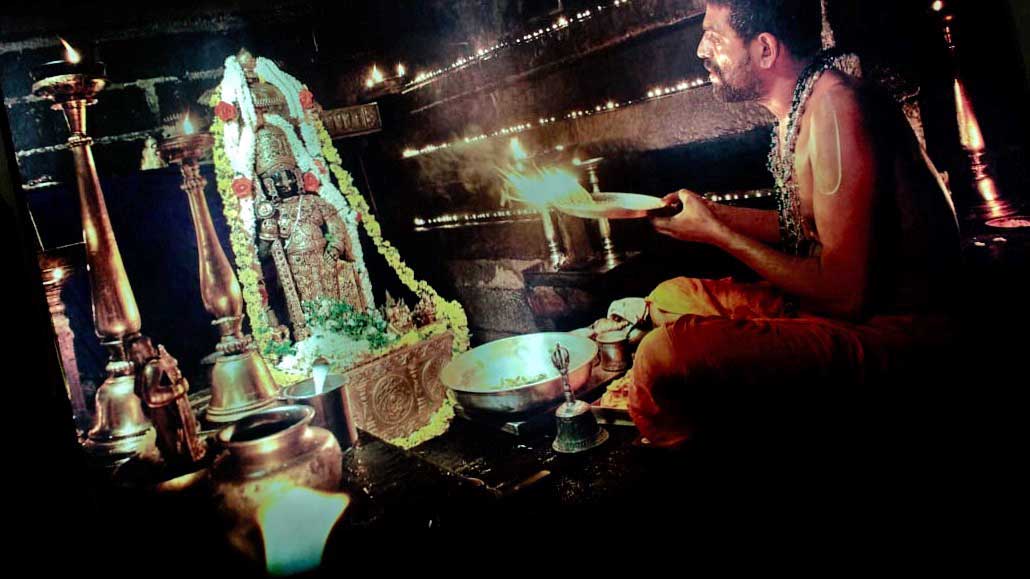 Pooja to SRI KRISHNA Krishna belonged to the Yadava clan whose capital city was known as Mathura. He was the eighth son of Vasudeva and Devaki. His father was a scion of the race of the Yadavas and his mother was the sister of the reigning king, known as Kamsa. He was a wicked king and everybody hated him. After the wedding of Devaki and Vasudeva, Kamsa decided to drive the couple to their own palace and took up the reigns of the chariot. Hardly had they gone a few paces when a heavenly voice declared that Kamsa would be killed by the eighth child of Vasudeva and Devaki. Kamsa immediately jumped out of the carriage and pulled his sister down by her hair and was all set to decapitate her. Vasudeva restrained him and promised that he would hand over all his children to him as soon as they were born. Kamsa was not satisfied with this and thought it better to keep an eye on the suspicious pair. So he clapped them in the dungeon, making sure that they could not smuggle their children out. Devaki gave birth to seven sons and each one of them was killed by Kamsa by smashing its head on a stone kept for this purpose in the dungeon so that the parents could get a good view of what was going on! Kamsa did not want to take chances on the eighth child so he chained Vasudeva and Devaki on opposite pillars. However the Lord appeared to Vasudeva in a dream and showed him his wondrous form as Vishnu. He imparted this vision in all its details to Devaki and she is said to have conceived her eighth child in this miraculous fashion. When Kamsa heard of this he doubled the guards and gave strict instructions that no one should be allowed to enter or depart from the dungeon and that the news of Devaki’s delivery should be brought to him immediately. However the Lord arranged everything with his father and as soon as he was born he was whisked away by Vasudeva to the cow-herd settlement of Gokula, to the house of the cow-herd chief, Nanda who was his friend. That very night Nanda’s wife Yashoda had given birth to a baby girl. Vasudeva was told to take his son and exchange him for the baby girl. All the instructions given by the Lord had been carried out and Krishna grew up as the son of Nanda and Yashoda. Poor Devaki had been denied the blissful experience of seeing the Lord’s play as a child – Balakrishna. Long afterwards when Krishna shifted his people from Mathura to Dwaraka, Devaki told him of her desire to see him in his form as a child. In order to please his mother, Krishna is supposed to have taken his babyish form and regaled her with all his childish pranks. His wife Rukmani also had the good fortune to see this play. She was enchanted and expressed her wish to have an idol of him as a child. Krishna ordered the great architect and sculptor Vishwakarma to make an idol of him as Balakrishna. The sculptor made a beautiful idol out of the fossil stone known as a “saligrama”. This is the idol which is seen today in Udupi. He is seen in his form as Balakrishna (child Krishna), holding the wooden churn with which his mother Yashoda used to churn the curd and make butter for him. This idol was worshipped by Rukmani in Dwaraka during the whole period while Krishna was residing there. Rukmani used to pour a kind of sandal paste, known as “Gopi chandan” over it regularly and very soon the whole idol was plastered with this and the features could not be seen at all. 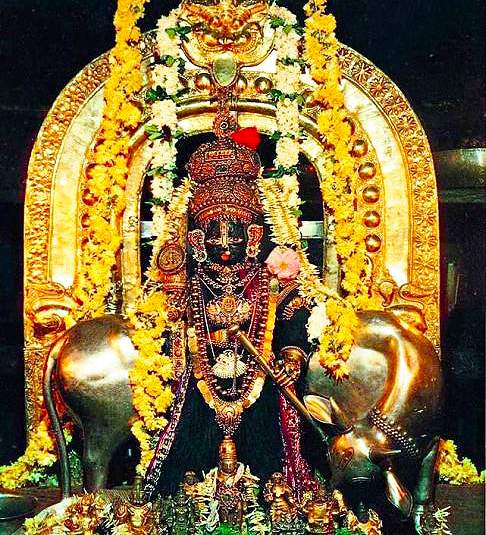 SRI KRISHNA When the time came for Krishna to leave this world, he prophesied that the city of Dwaraka would be taken back into the sea from which he had reclaimed it long ago. In the deluge that ensued after his departure, the whole of the city of Dwaraka sank into the ocean and the idol was washed away by the sea. Many centuries passed and the idol covered by sandal paste was found by a sailor on an island on the south western coast of India. It was hard as rock and very heavy so the sailor began using it as a weight to balance his boat. Once his ship was caught in a storm off the west coast of South India and was in dire peril. Just at that time the great sage Sri Madhavacharya had come to offer his ablutions on the sea-shore. He saw the desperate state of the ship and prayed to Lord Vishnu to save it. He waved his garment and beckoned the ship to come ashore. Miraculously the raging storm abated and the ship moved safely to the harbour. The sailor was overcome with gratitude and fell at the feet of the sage and begged him to accept something from the ship as a token of his gratefulness. Somehow the saint’s eyes were drawn to the block of stone which was being used by the sailor as ballast. He agreed to accept it and the sailor happily gave it to him. The sage took it home and felt that it contained something of vital importance to him. He started chipping away at the sandal that had become hard as rock and as he chipped away, the face of his favourite deity started to emerge. He couldn’t believe it and carefully chipped away at the rest of the so-called stone and discovered the precious idol of his beloved Krishna. Later through his divine vision he realised that the idol was the one that had been worshipped by Rukmani, the wife of Krishna during the Krishnavatara (the age of Krishna). Happily singing the praises of his darling, he carried the precious gift to his ashram or “mutt” in Udupi which was only four kilometres from the beach known as Malpa beach. The very touch of his divine hands was enough to restore all powers to the idol which he installed and consecrated with great joy in a temple in the mutt. As is normal with many temples the idol was facing east when he installed it. But now when we go to worship, we find the idol facing west. There is a very fascinating story connected with this. 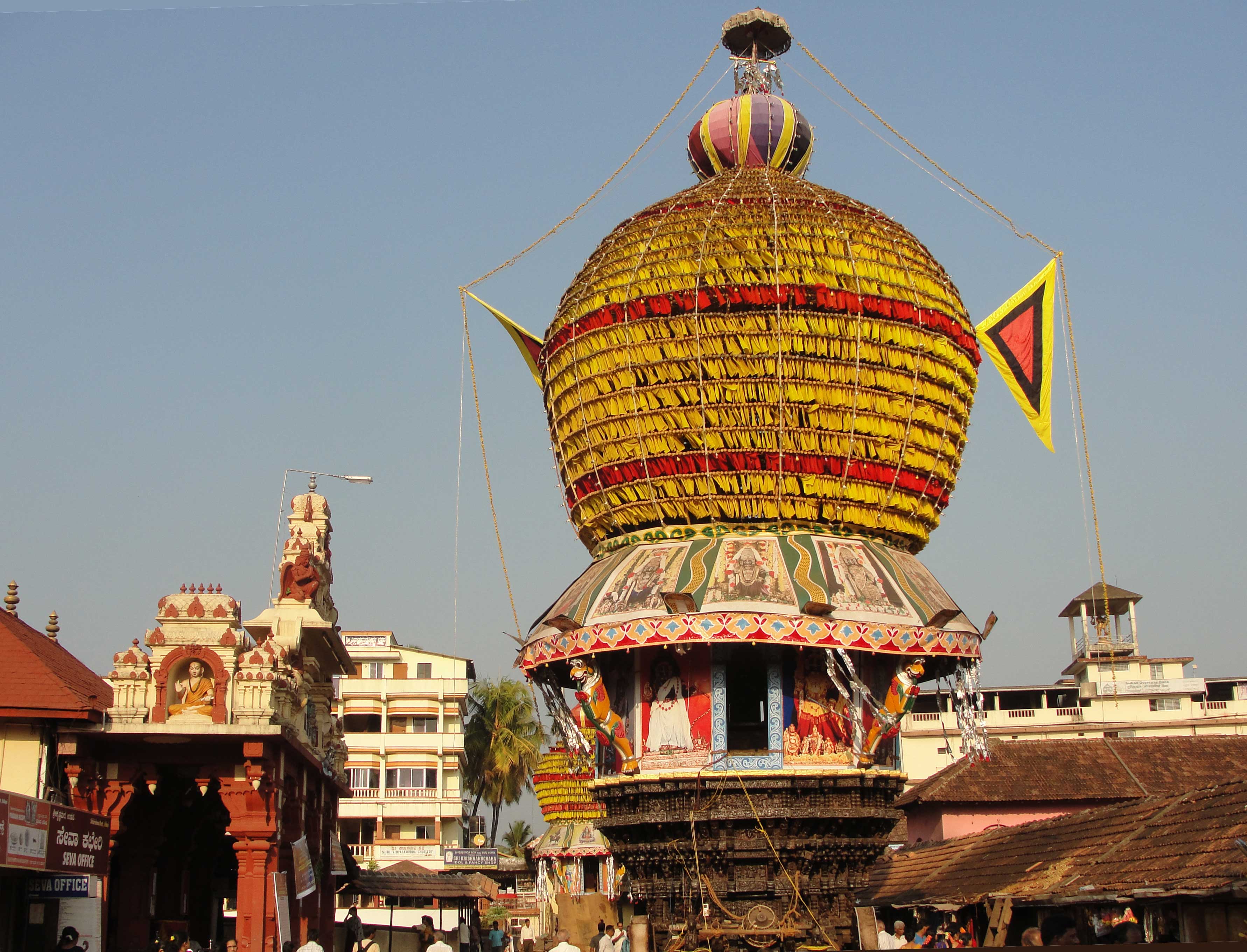 Decorated Chariot, Udupi Once long ago
there was a great devotee of the Lord known as Kanakadasa. He belonged
to a low caste and was denied entry through the eastern entrance. Only
upper castes were allowed to go through the eastern entrance. All lower
castes were made to peer through the slits of a granite window on the
western side. The desperate devotee ran round and round the temple
hoping to have a glimpse of his beloved deity. At last he went to the
western entrance which had the window made of granite with three
vertical openings. This can be seen even today. He peered through the
slits but still could only see the back of the Lord. He beat his breasts
and begged Krishna to give him darshan. Krishna is said to be the ocean
of compassion and the slave of his devotees. The next day when the
Brahmin priest went to open the door on the eastern side he found that
the whole idol had turned and faced west so that his faithful devotee
could have his darshan! He never turned round again and even today he
can only be seen through a window with nine square holes, facing the
west. Udupi was a stronghold of the Brahmins, who were fiercely
insistent on their rights. They refused to let the lower castes inside
the temple. It is as if in punishment for this cruel law that the Lord
decreed that from that day onwards everyone could see him only through
these holes. It looks as if the Lord did not want the upper castes to
have an advantage that was denied to his low caste devotees! Even today
no one is allowed to block the granite window that gives direct vision
of all the pujas that are being carried on inside. No visit to Udupi is
complete without taking a round of the temple from the outside and
peeping through the granite window on the western side.
There are three schools of Vedanta philosophy known as Advaita Vedanta, Visishtadvaita and Dwaita. These can broadly be described as Non-dualism, qualified Non-dualism and Dualism. The great saints who preached these three forms which are all derived from the Veda are Adi Shankaracharya for Advaita, Ramanucharya for Visishtadvaita and Madvacharya for Dwaita. The Udupi mutt is the stronghold of the Dwaita tradition since Madvacharya belonged to this place. Though all these three traditions follow the Veda yet there are a few differences. Advaita proclaims that Reality is one and the jivatma (embodied soul) is the same as the Paramatma (Supreme Soul or Brahman). Moksha or liberation is the merging of the jivatma with the Paramatma. Visishtadvaita says that though they both have the same origin, there are certain differences and one cannot completely merge with the Brahman. Dwaita unequivocally states that the Jeevatma and Paramatma are totally different from each other and one can never become the other. Krishna is the supreme expression of the Paramatma and the individual soul can approach him only through devotion or bhakti. 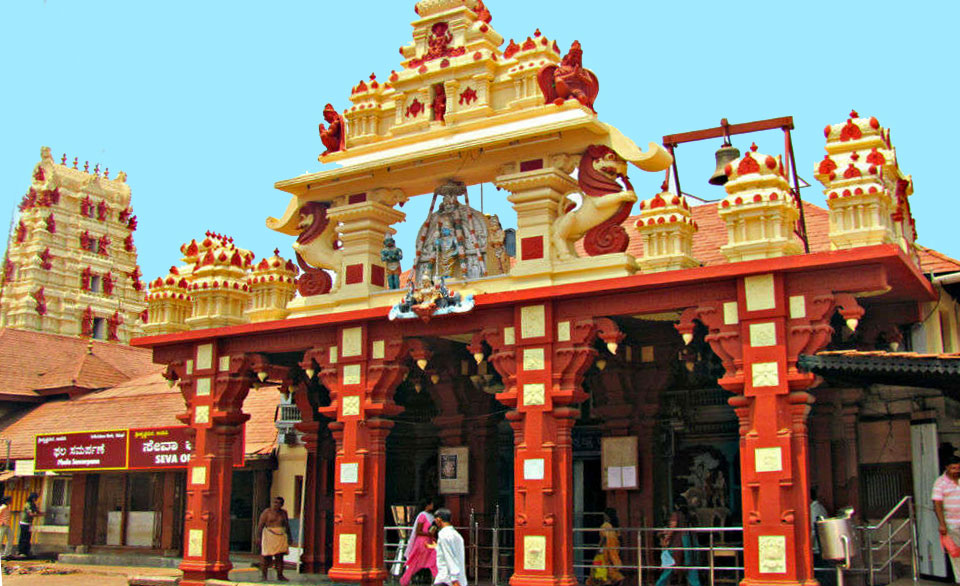
Though I’m an Advaitin intellectually, the fact is that in practice I’m a total bhakta or devotee and my favorite deity is definitely Krishna. I have been to most of the great Krishna temples of this country and had gone to Udupi a couple of times before. But both these visits had been most unsatisfactory. I’m a firm believer in the fact that the deity of any temple will not reveal himself totally to a casual visitor who wants a short cut to liberation and runs in and out and is satisfied with a quick glimpse of the deity enshrined inside the sanctum. I had been longing to go and stay for some time at Udupi since the form of the Lord fascinated me and the story of his great grace and love for his lowly devotee had made a great impact on me. But there is a time for everything and that time has to be decided by the Lord himself. His wish to see his devotee must be as great as the devotee’s desire to see him! That time happened last month when I was given the call to go to Udupi and stay there for five days. 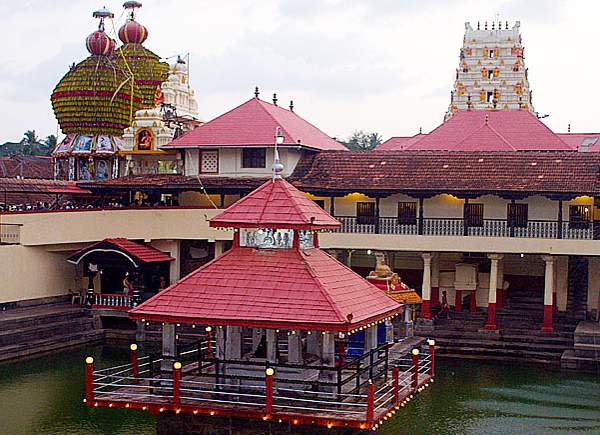 Holy Tank Madhwapushkarani 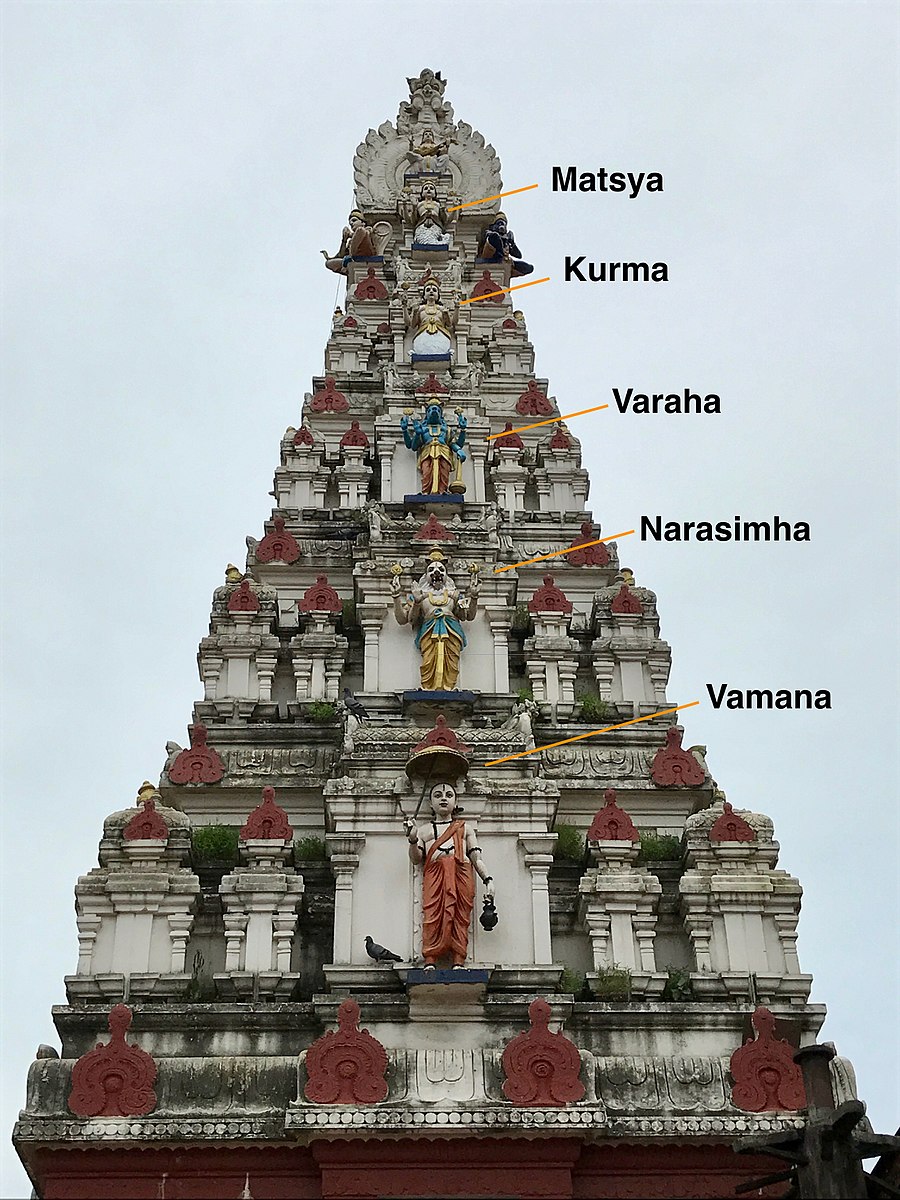 Incarnations of Lord Vishnu on Udupi Gopuram For the first two days I attended every arati and puja however tiring it was. I was guided and supported by His infinite grace which made everything a delight. Of course the crowd would increase as the day wore on but those precious hours of the morning was something that I will treasure for the rest of my life. This was the only time that one would get to see the idol in its original state as the black saligrama stone without any ornaments or clothes. Every day he would be dressed in a new type of clothes. Strangely enough on Friday I found that he was dressed as Durga, holding trident and a lion nuzzling close to her! Apparently this was the usual custom. All temples have secret places which are not available to the casual visitor. It was only on the third day that I discovered a very interesting thing. On the north side there is a door leading into the sanctum used by all the priests. I poked my head through this door and turned my head to the right and was charmed to see a true replica of the idol of Balakrishna right there in all his glory in a little niche. It was so close I could easily touch it and obviously the priests were doing puja to this also since it was clad in splendid accoutrements, just as it was in the main sanctum. But here one could a clear picture without the annoying holes. I looked at him and laughed and I was sure he winked at me. It was always his way to give only tantalizing glimpses until one proved one’s worth!! There is another room beyond this in which is kept the golden cradle on which he is rocked to sleep at night. Normally this is a secret puja or “ekantha seva” done by the priests but in the winter months apparently the cradle is brought out and everyone can witness it. This is known as “shayanotsava”. 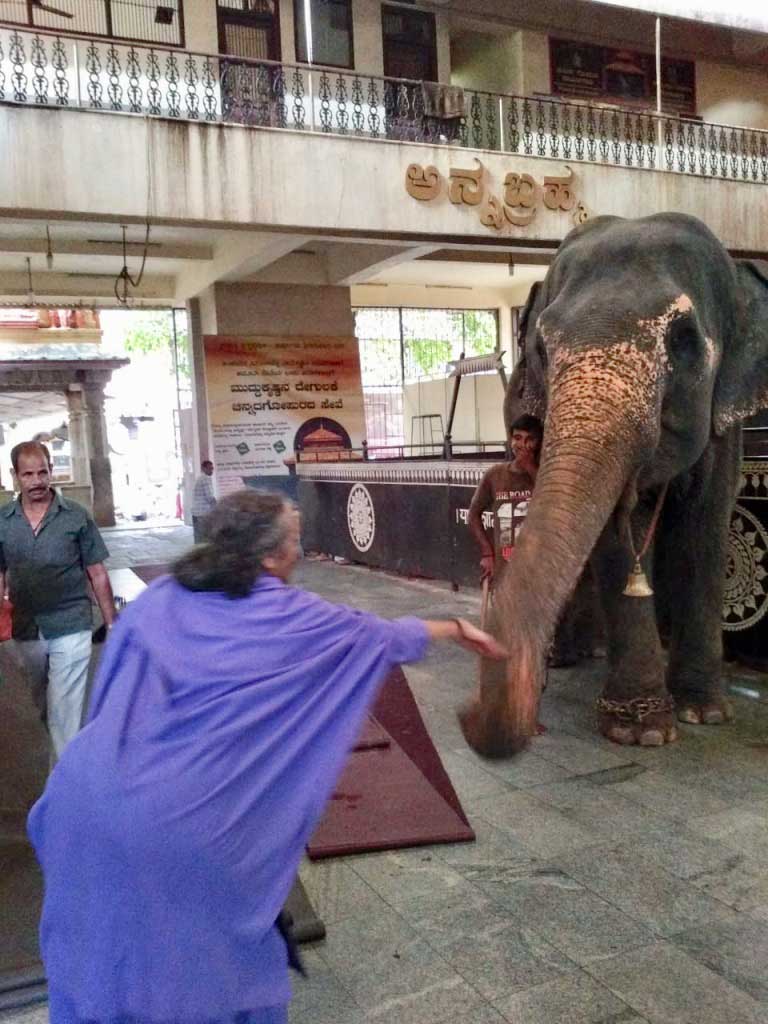 Every evening after the final arati while the baby Krishna is made to sleep, there is a beautiful lullaby that is sung to him. I could close my eyes and imagine him being rocked to sleep as the lullaby was being sung outside. Every day a new person would sing it and all of them had wonderful voices. They used to sing some other devotional songs also before the lullaby. I knew one Kannada song that had been specially written for Udupi Krishna so I went and asked the lady to please sing that particular one. It is called “Krishna nee begane baaro” and means, “Krishna please come soon to me”. She said, “I was planning to sing this today and I see that Krishna wants it and has sent you to remind me.” My eye filled with tears at His grace which was shown even in the minutest things. As she started her song all the people in the temple were spell bound and everyone started to hum or sing along with her so that there was paean of joy rising up to the roof. Like the waves on the Malpa beach the waves of the song cascaded over me and drenched my eyes and I threw myself on the floor and sobbed my heart out in gratitude for having shown such love to this poor unworthy soul. The temple gives free lunch and dinner to all devotees so of course I went one day to have it. Also made a visit to Malpa beach where Madhwacharya had discovered the idol. Sad to say there was no board or anything on the beach to describe this event which is such an important incident in the history of the temple. Hindus have no idea of how to preserve and advertise their great heritage. On the other hand there were numerous boards advertising boat rides to St. Mary’s island where Vasco de Gama was supposed to have landed before he proceeded to go ashore and start his great mission of converting the poor heathens!! There were many very ancient temples around Udupi. I did go to a few but for me every minute spent away from my darling Balakrishna seemed a waste of time so I always hurried back to try and catch the next puja. He played many, many tricks on me during the five days stay that can only be experienced by each devotee for such things are precious and have great meaning only to the devotee and the deity. After five blissful days, I left that divine presence filled with inexplicable joy. On the last day after the arati as I as leaving the temple I turned back again and again eyes brimming with tears for I knew that I would never be given another chance to have such a darshan again. 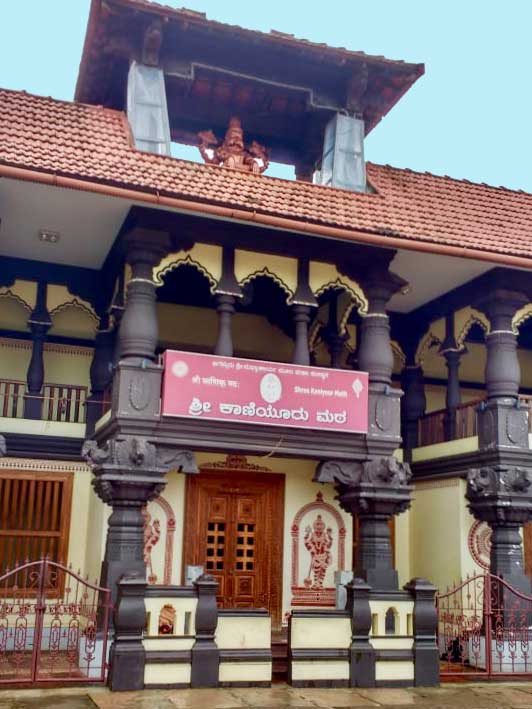 Udupi Shri Krishna Matha  Overlooking the Chandrasala hall is a four-pillared raised platform with a silver roof. The platform houses the traditional deepastambam, holding the sacred oil lamp. |